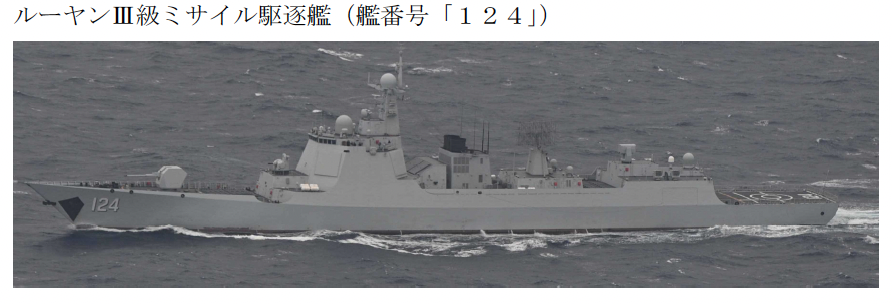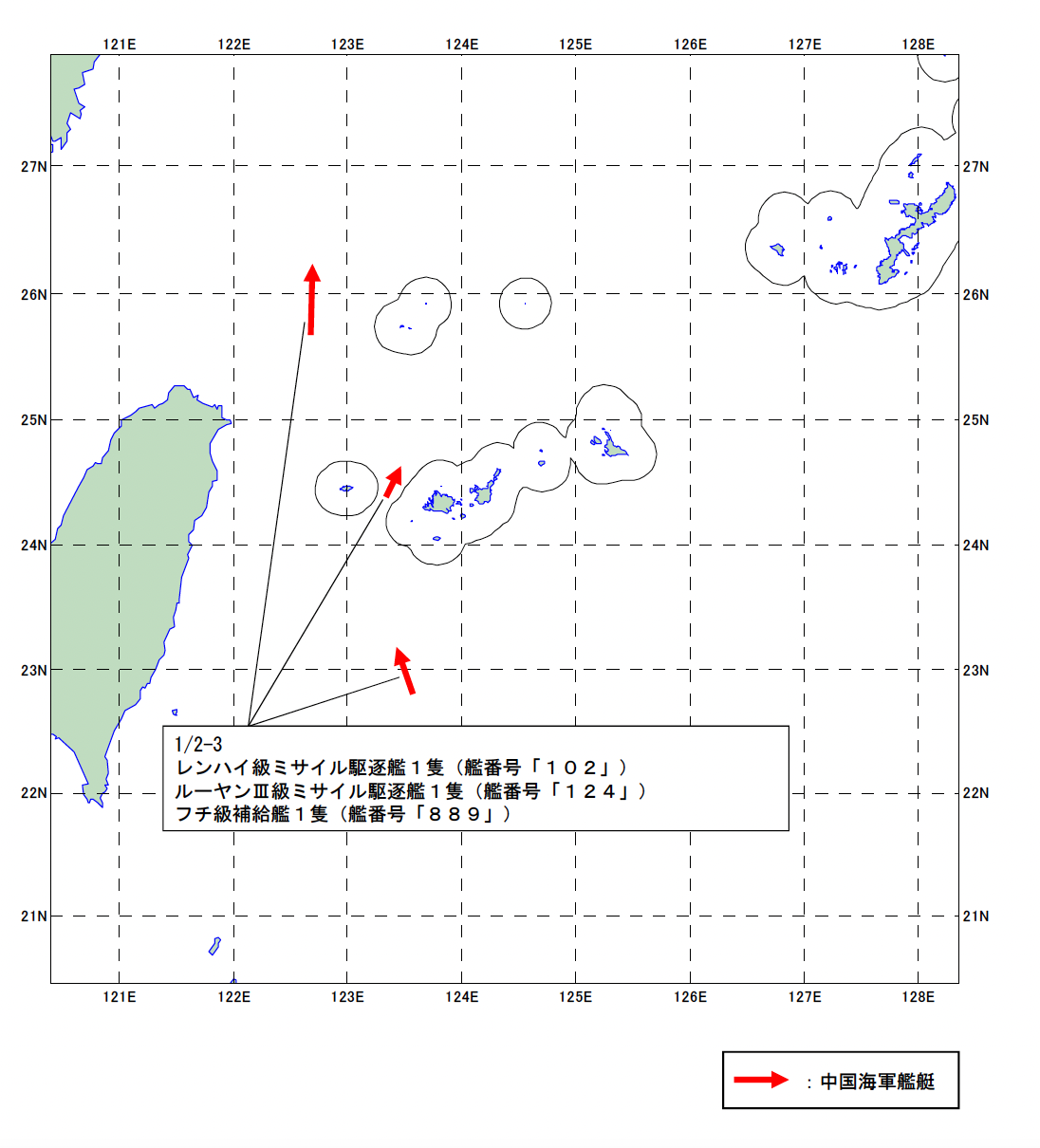
A People’s Liberation Army Navy (PLAN) surface action group and surveillance ship have returned to the East China Sea from the Pacific Ocean after operating there for the last few weeks.
On Monday at 11 p.m., three PLAN ships were sighted sailing northwest in an area 160 kilometers southeast of Yonaguni island, according to a Wednesday news release from Japan’s Joint Staff Office (JSO) of the Ministry of Defense. Yonaguni Island lies 108 kilometers from the east coast of Taiwan. Images and hull numbers provided in the release identified the ships as cruiser CNS Lhasa (102), destroyer CNS Kaifeng (124) and replenishment ship CNS Taihu (889).
On Tuesday, according to the release, the PLAN surface action group was sighted sailing northeastwards in an area between Yonaguni Island and Iriomote Island, and then sailed northwards in an area 70 kilometers west of Uotsuri Island, part of the disputed Senkaku Islands held by Japan and claimed by China and Taiwan.
Japan Maritime Self-Defense Force destroyer escort JS Tone (DE-234), a JMSDF P-1 Maritime Patrol Aircraft (MPA) of Fleet Air Wing 1 based at JMSDF Kanoya Air Base, Kyushu and a JMSDF P-3C Orion MPA of Fleet Air Wing 5 based at Naha Air Base, Okinawa monitored the PLAN ships.

Also on Wednesday, the JSO said a PLAN Dongdiao-class surveillance ship was sighted that day at 4 am. sailing northwards in an area 60 kilometers east of Miyako Island. The hull number and image provided in the release identified the ship as CNS Kaiyangxing (796). The PLAN ship then sailed northwards in the Miyako Strait into the East China Sea, according to the release, which noted that the ship had sailed southeast through the Miyako Strait on Dec. 14. A JMSDF P-3C Orion of Fleet Air Wing 5 shadowed the PLAN ship.
Meanwhile, China’s Ministry of National Defense on Thursday released a video showing J-15 fighters conducting flight operations in the South China Sea from carrier CNS Shandong (17). In the video, the MND only said the carrier had recently carried out a combat training exercise in the South China Sea and that “a number of J-15 fighter jets took off from the carrier and fought fiercely in the air. On the flight deck of the aircraft carrier, an emergency response drill to tackle arresting gear failure was carried out simultaneously,” according to the MND.
In Japan on Friday, Japan Defense Minister Yasukazu Hamada announced that he and Foreign Minister Yoshimasa Hayashi will hold a 2+2 Japan-U.S. Security Consultative Committee talk on Jan. 11 in Washington, D.C., with their respective U.S counterparts: Secretary of Defense Lloyd Austin and Secretary of State Antony Blinken. Hamada and Austin will also hold a Japan-U.S. Defense Ministerial Meeting.
The two events comes before the Jan. 13 meeting in Washington between President Joe Biden and Japan Prime Minister Fumio Kishida, in which the two leaders will “discuss a range of regional and global issues including the Democratic People’s Republic of Korea’s unlawful weapons of mass destruction and ballistic missile programs, Russia’s brutal war against Ukraine, and maintaining peace and stability across the Taiwan Strait,” according to a White House news release issued earlier this week.
Over in Korea, the Republic of Korea Navy (ROKN) announced on Friday that it had conducted squadron level drills for its three fleet commands on Wednesday as part of its regular annual evaluation of combat readiness for its fleets, along with squadron level training at the start of the year. The ROKN’s 2nd Fleet conducted drills in the waters of the Yellow Sea in an area 80 kilometers west of the Taean Peninsula.
The ships conducting the drills included destroyer ROKS Eulji Mundeok (DDH-972), frigate ROKS Gyeonggi (FFG-812), missile patrol vessel ROKS Hong Siuk (PKG-723) and a Gumdoksuri-class patrol vessel, along with ROKN AW-159 Wildcat helicopters. The drills included helicopter launch and landings, tactical maneuvers and anti-ship and anti-air naval gunfire. Meanwhile, the 1st and 3rd Fleets conducted a combined drill in the East Sea and Yellow Sea with frigates ROKS Daegu (FFG-818), ROKS Donghae (FFG-822) and ROKS Gwangju (FFG-817); missile patrol vessels ROKS Lim Byeongrae (PKG-722), ROKS Kim Changhak (PKG-727) and ROKS Lee Byungchul (PKG-733); and several Gumdoksuri-class patrol vessels. The ships performed tactical manuevers and gunfire drills.
In Australia on Thursday, the Department of Defense issued a release stating it reached a deal with Norway’s Kongsberg to purchase the Naval Strike Missiles (NSM) to replace the Harpoon missile systems on the Royal Australian Navy’s eight Anzac-class frigates and three Hobart-class destroyers, with the replacements entering the fleet starting in 2024. With the NSMs and the purchase of the High Mobility Artillery Rocket System (HIMARS) systems for the Australian Army, the Australian Defense Department is spending AUD $1 billion, or USD $677 million, according to the release.





